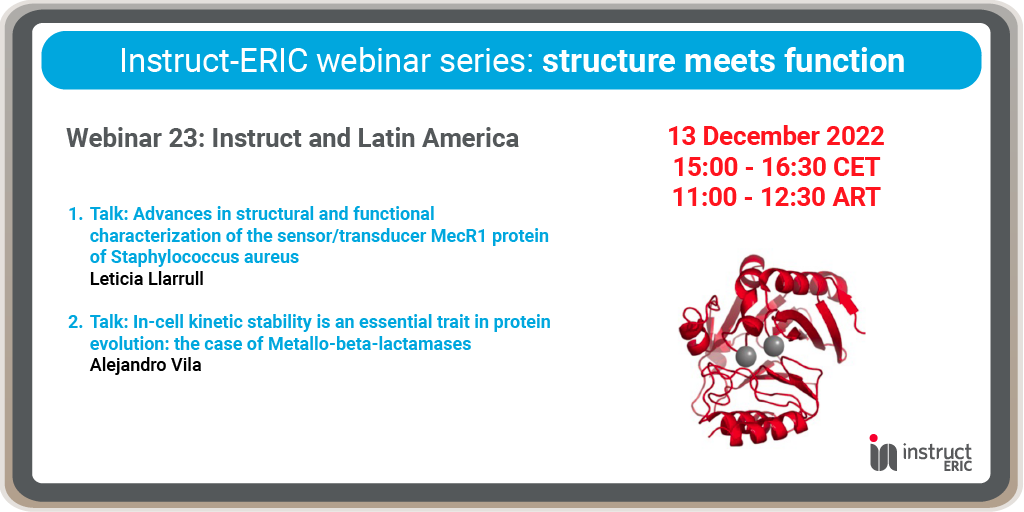 Instruct
InstructThe latest webinar in the Instruct-ERIC Structure Meets Function series is a special edition. This month, guest speakers from Instruct's partner institutions in Latin America will give talks on the work they completed as part of the International Call. Register for the webinar here.
The international call was conducted in the context of the EU-LAC ResInfra project. This project aims to harbour collaborative efforts between Europe and Latin America and the Caribbean. This has been through access calls, staff exchanges, bi-regional events and more! Find out more about Instruct-ERIC's international collaboration here.
This month, both speakers are representing IBR-CONICET in Argentina: Leticia Llarrull and Alejandro Vila!
The webinar took place 15:00 CET (11:00 ART, 14:00 GMT), on 13 December
Take a look at the previous webinars in the series here.
Moderator: Ana Zeri, LNLS
Speaker 1: Leticia Llarrull, IBR-CONICET
Talk Title: Advances in structural and functional characterization of the sensor/transducer MecR1 protein of Staphylococcus aureus
Abstract: Methicillin resistant Staphylococcus aureus (MRSA) is a pathogen that poses a worldwide threat. Resistance to β-lactams in MRSA is inducible, and MecR1 regulates expression of PBP2a, the main resistance determinant. We are interested in unveiling how the presence of β-lactams activate this metalloprotease, resulting in manifestation of resistance, and on understanding the functional differences with its homologue, BlaR1 from S. aureus, which regulates expression of a serin-β-lactamase. To date, no high-resolution model of full-length MecR1 or BlaR1 is available.
Speaker 2: Alejandro Vila, IBR-CONICET
Talk Title: In-cell kinetic stability is an essential trait in protein evolution: the case of Metallo-beta-lactamases
Abstract: Protein stability is essential for biological function. In contrast to the vast knowledge on the thermodynamics of protein stability in vitro, little is known about the factors governing the in-cell stability, that defines the lifetime of the native state of proteins within the cell. Here we show that the kinetic stability of the metallo-β-lactamase NDM-1 in the bacterial periplasm is optimized to face metal restriction at the host-pathogen interface. NDM-1 is one of the main responsible of providing resistance to carbapenems in pathogenic bacteria. Despite its high stability in vitro, the non-metalated (apo) NDM-1 is unstable in the bacterial periplasm. NMR reveals that metal dissociations endows the apo-enzyme with flexibility at the C-terminal helices, that enable recognition by specific periplasmic proteases, or to aggregation. Zn(II) binding renders the protein refractory to degradation by quenching this flexibility. Apo-NDM-1 is anchored to the outer membrane, a localization that renders it less accessible to the proteases and less prone to aggregate. More recent clinical variants of NDM accumulate mutations that quench this flexibility therefore enhancing their stability towards proteolysis. This work provides direct evidence of how the kinetic stability of a protein optimized within the bacterial cell, and links metallo-β-lactamase-mediated resistance with the cellular metabolism in the periplasm. In cell NMR also reveals information on the degradation pathway, providing insights into the physiology of the bacterial periplasm.
